I’m nearly done with David Marler’s new book Triangular UFOs: An Estimate of the Situation. In my preliminary thoughts about the book, I discussed the logical inadequacies of some of the assertions in the book’s preface, written by Col. John B. Alexander. The gist of my criticism of Alexander’s material was that he caricatured “conspiracist” thinking (which he defines as any view of the UFO problem that doesn’t end up embracing an alien explanation) and did so by means of flawed logic. I was also critical of the fact that neither Alexander or Marler, who really can think of themselves as well versed in UFO research, cared to factor in what is known about dirigible technology for explaining triangular craft. I’d like to expand on that omission in this post. Despite what follows, I would recommend the book to all those interested in serious study of the UFO phenomenon.
What’s My Point – in General
In what follows I’ll sketch the fact that dirigible airship technology has been known since the Civil War, at least in terms of the U. S. Patent Office and the “great airship controversy” of the 1890s. This is, for my money, important, since most of the behavior of triangular UFOs aligns pretty well with dirigibles (low speed, turning without banking). The exception would be high speed behavior, but Marler himself offers some explanations for at least some of the cases where high speed is a factor that could be used in defense of dirigible technology.1 Nick Redfern All the above makes it very odd that the words “dirigible” and “airship” do not even appear in Marler’s index. It’s as though research in that direction and behavioral overlap didn’t even register with him. Since those terms don’t appear in his index, it makes sense that the names of Busby and Danelek are also absent. They are the authors of the two major books on the airship sightings in the late 1890s.2
What I’m Not Claiming
Let’s get what I’m not saying out the way as we begin. The gist of what I’ll be saying here is that what’s known about airships from the 1800s onward to the continued aviation interest in them in our own time ought to be part of the discussion of a UFO that behaves in the manner of the triangles.3 Frankly, avoiding the data in that regard strikes me as very unreasonable. I think as we proceed you’ll see why. I’m not going to claim that dirigible airship technology is “the” explanation for triangular craft, or even that there is a direct line of evolution from the early patents to today. For sure one could make that case, but that wouldn’t actually prove that airships are behind the triangular UFOs. It would only provide a working theory. I don’t know that triangular UFOs are dirigible, even nuclear ones (And yes, such things have been on the drawing board for some time as we’ll see below). I’m no more omniscient than Colonel Alexander, but I’ll be more up front about that. What I do know is that this technology deserves to be part of the discussion.
A Visit to the U. S. Patent Office
I’m not going to take the space to give readers a full tour of patents related to airships / dirigibles / aerostats. If you’re interested, you can put those terms into a search at the U. S. Patent Office yourself. What follows are examples of what you’d find.
We’ll begin with Busby’s book. He has a scan of a patent (#43,449) from 1864 (pages 355-356). Here’s the page that shows the inventor’s illustrations (he called his idea an “aeron”). A pretty standard three-cylinder conception (the orientation is original):
 |
Interestingly enough, two issues of the MUFON Journal are relevant here in terms of chronology. The March 1982 issue had a sketch of an etching of something sighted in the sky in 1894 (note the propellers; they will show up later):
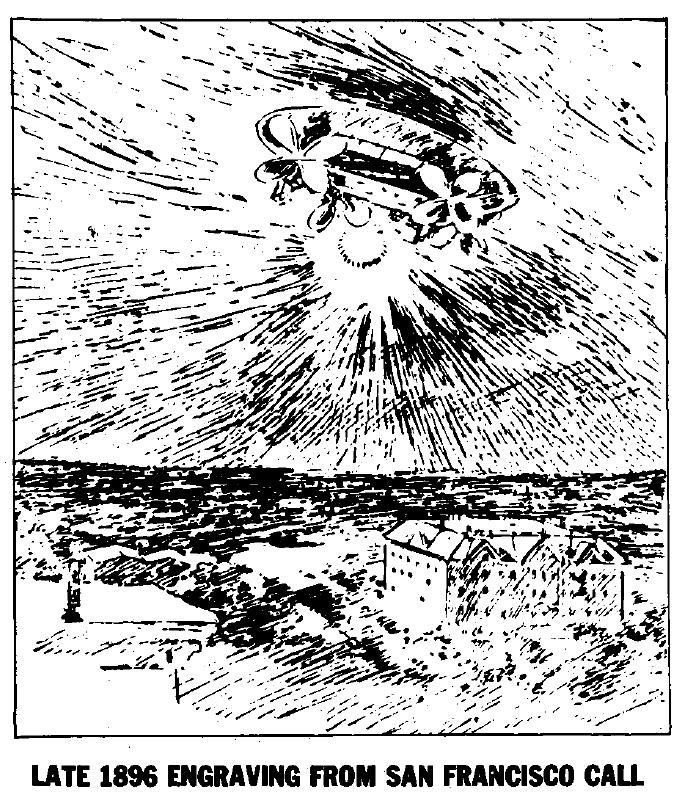 |
That was followed by this patent of the same year (1894) that appeared on the May 1982 cover of MUFON Journal:
 |
I wanted you to note the propellers because it’s representative of propeller technology associated with dirigibles in other patents you’ll find when searching the database. This one in particular drew my interest (see the red square):
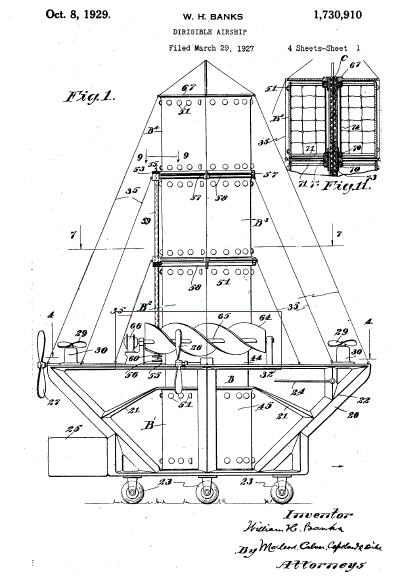  |
The second of these last two images is how the airship would appear from the bottom. That is, this airship would look like a diamond or, if partially obscured, a triangle. (Marler includes diamond-shaped objects in his book).
More triangular is this 1921 airship patent. First a side view:
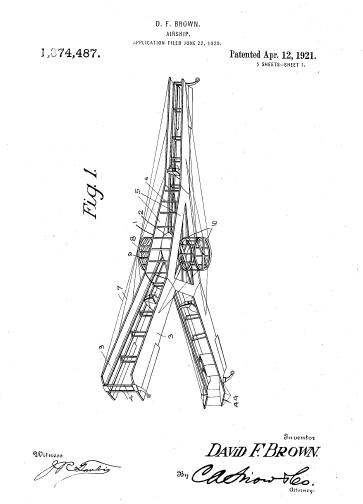 |
Now a bottom view.
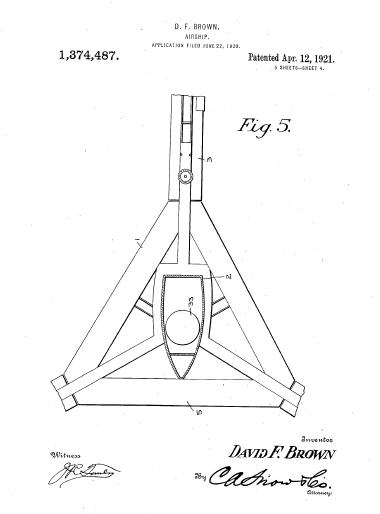 |
Frankly, if that doesn’t match what lots of people are seeing and drawing with respect to triangular UFOs, I don’t know what would. But again, it doesn’t prove a connection. It just demonstrates that a connection is certainly possible and ought to be part of the discussion. I have to wonder why it was missed by David Marler and Colonel Alexander.
Now, you might say, “well, that was the 1920s, what about now?” Patience. We’re not through with the old ones yet.
Dirigible technology from the 1920s not only gives us the cigar-shape and triangular UFO, but also the good old-fashioned saucer. Some examples:
1917 patent:
 |
1927 patent (the “Fig 4” note orients you – that’s the top, so from below, this is an ovoid):
 |
1929 patent:
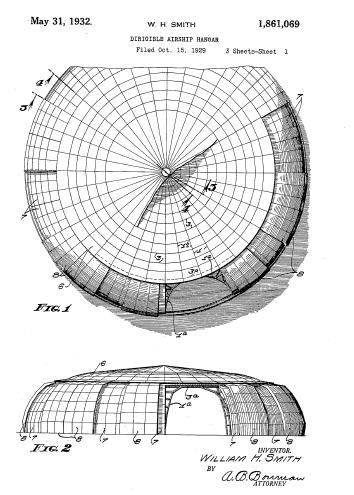 |
I think that’s enough to make the point. That there are UFO sightings of various shapes earlier than WWII doesn’t impress me so much. Again, I don’t think dirigible explain all the reports, but that sort of technology can explain a lot of sightings earlier than the jet era.
More Recently
But what about the modern era? Oh, there’s plenty of interest in dirigible technology. And news flash to Colonel Alexander: the military and defense contractors are involved in triangular dirigible technology.
I almost don’t know where to start here. This connection has been reported by writers and bloggers on the UFO beat before. Here’s a smattering of examples.
Defense Tech reported this past January that NASA and the DoD have invested $35 million in prototype testing of an “Aero” that is a precursor to a 450-foot-long vehicle that can carry 66 tons of payload. The prototype looks like this:
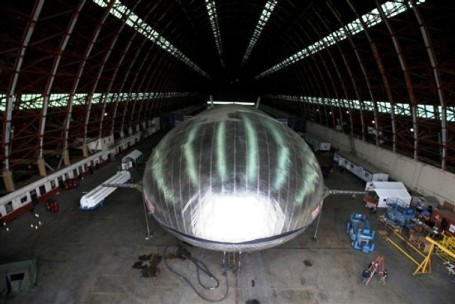 |
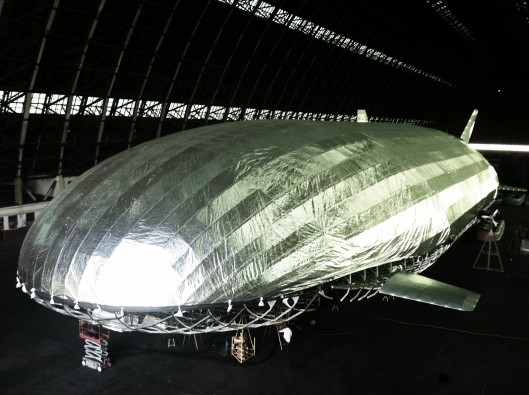 |
This Aero-craft is being developed by Worldwide Aeros. As the link above notes, “It looks like a blimp but technically it isn’t one because it has a rigid structure made out of ultra-light carbon fiber and aluminum underneath its high-tech Mylar skin. Inside, balloons hold the helium that gives the vehicle lift. Unlike hydrogen, the gas used in the Hindenburg airship that crashed in 1937, helium is not flammable.”
Further, “According to an AP report posted at Military.com, the airship functions like a submarine, releasing air to rise and taking in air to descend. It can take off vertically, like a helicopter, then change its buoyancy to become heavier than air for landing and unloading.”
Interesting, but it’s only to make the point that defense contractors are thinking (and if our tour was more in-depth, have thought about, for a long time) airship / dirigible technology and its military applications. Let’s “triangulate” a little more (sorry, couldn’t resist that).
Here’s a pudgy triangle dirigible craft by Lockheed Martin: the SkyTug
 |
This is just the latest such model, though. Other UFO sites and blogs have noted how triangular dirigible craft provide explanatory power for many aspects of sightings like the Belgian Wave and the Phoenix lights. But it seems no one is paying attention. Aliens are sexier. By way of example, the Stealth Blimp site notes:
“In 1981 the Navy contracted Lockheed Martin to develop a lighter-than-air (LTA) high altitude surveillance platform called HI-SPOT—HI Surveillance Platform for Over-the-horizon Targeting. At around the same time, NASA launched a similar program called HAPP—the High Altitude Powered Platform, which was designed to be a flying radar surveillance station.Feasibility studies for both these programs were conducted by ILC Dover. You can download their Final Report on the Design Definition of the Lighter-Than-Air High Altitude Powered Platform, directly from NASA’s online archives. And you can download the report on Phase II of the study from the Corporation for National Research Initiatives.”
The same site adds:
“In 2009 the army decided they needed a giant surveillance airship for the battlefield and called the proposal the LEMV (long-endurance multi-intelligence vehicle). In 2010 Northrop Grumman announced the contract to build this vehicle with a first flight in 2011. While this development isn’t proof positive of a similar “classified” program, it goes a long way towards proving the critical need for such a platform exists.”
But for our purposes, the giant airship triangle below is much more telling. I’m not sure how Marler and Colonel Alexander missed this, as it was reported back in 2009 by UFO Mystic (“Pentagon Plans Airship UAVs“) and Real UFOs (“High Altitude Airships Similar Design to Large Triangle UFOs“). The latter link reveals some stunning photographs. It’s a triangle, and its pretty big.
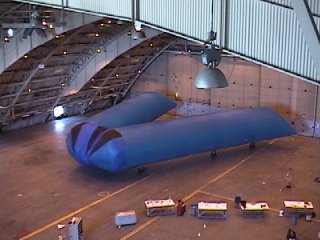 |
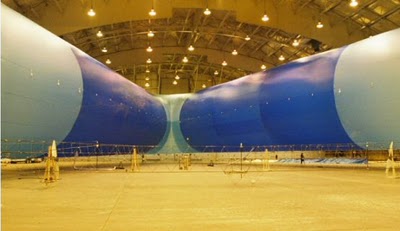 |
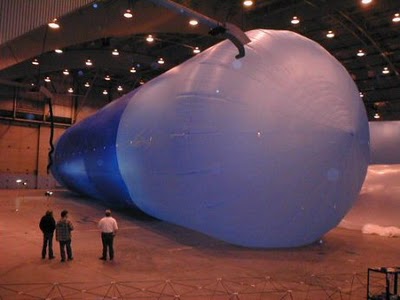 |
None of this should be shocking. Back in 1999 a Popular Mechanics article (“Skunk Works Magic”) talked about the stealth blimp.
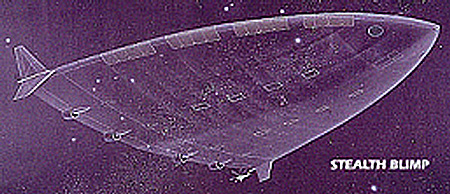 |
Back in 2002, NIDS (National Institute for Discovery Science), funded by UFO enthusiast Robert Bigelow, published a report about triangular UFOs, concluding it was plausible (but of course not certain) that the answer was DoD triangular blimps.
NIDS only had any hesitation the DoD explanation because of the openness of the sightings – there was no attempt, it seemed, to hide the flights. This suggested that it wasn’t a covert program. Maybe it isn’t (or maybe it is). Maybe it’s private industry. The large, high-altitude triangular airships pictured above are being developed by JPAerospace. It’s a private company whose projects have been funded, at least in part, by crowdsourcing. Other businesses are interested in large high-altitude dirigibles that are semi-triangular. Here’s one that provides cellular service:
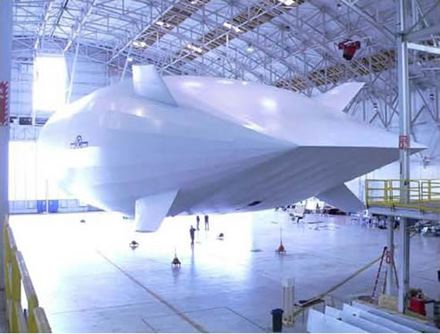 |
Still other designers and commercial interests are looking at using dirigible technology for flying hotels (“manned clouds”). I like the whale / manatee design of this one:
 |
Again, these are just samples from about two hours of research. Continuing …
The Orbital Airship
According to the Wikipedia entry on this craft:
“The orbital airship, also called the space blimp, is a proposed space transportation system that carries payloads to and from low Earth orbit. It is intended to achieve orbital altitude and orbital velocity using low thrust rocket propulsion by flying in the manner of an airship rather than arocket, employing buoyancy and aerodynamic lift rather than vertical thrust to sustain flight during its ascent.”
The note about orbital velocity is interesting. That’s really fast:
circular orbit: 7.8 to 6.9 km/s (17,450 mph to 15,430 mph) respectively
elliptic orbit: 8.2 to 6.5 km/s respectively
Now, for sure orbital velocity isn’t necessarily transferable to high-speed moves sometimes associated with triangular UFOs (and that is calculated based on sightings by multiple people in different locations, assuming the same craft is being seen). But that isn’t my point. My point is that there are dirigibles out there that can sustain amazing speeds and the forces that go along with those speeds.
Getting a little more edgy, dirigible technology actually – in theory – contributes to the discussion of some of the more bizarre details of large triangle sightings. The Labrador case is noteworthy, as the pilots who witnessed it reported smaller round craft that seemed to go into the “triangle mothership.”
The notion of airships being bases for smaller planes isn’t new. Here’s an example of the concept in 1934.
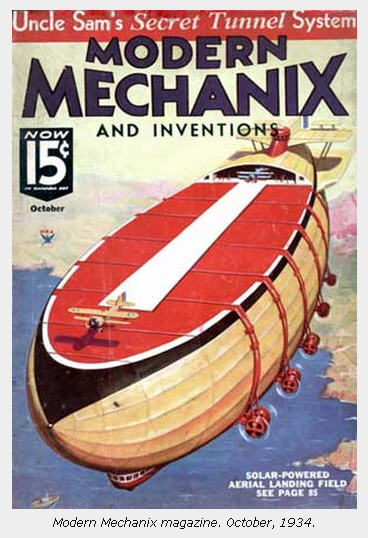 |
My point is not to argue that this concept was indeed developed and is behind the Labrador case or any other. My point is that the notion that this sort of thing is inconceivable to humans is bogus. The airships being developed by the defense industry now have huge payloads (note the 66 ton payload example earlier). Yeah, it could carry some other smaller craft, especially if they were dirigibles, too.
Other cases had witnesses saying the triangle changed shapes, specifically with two upturned ends like the handle on now-antique rotary telephones. Guess what – That can happen if your dirigible is segmented, as in the “Stealth Worm Airship” noted by Defense Tech in 2012:
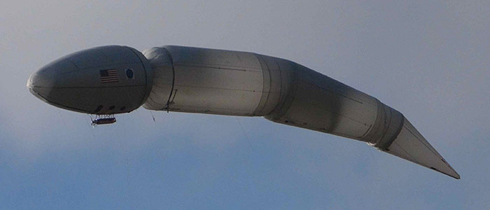 |
All you need is a “worm” long enough to produce the sort of effects witnesses have described, especially if the ends are powered for turning and other navigational needs. And if such a “worm” was powered on both ends, it could move in either direction as well.
Conclusion
I think readers know this wasn’t intended as a dissertation. I only spent a couple hours of research to produce this. One advantage is that I collect this sort of information. So, at the risk of repetition, let me say again that I’m not claiming any or all of these explanations are “the” answer to triangular UFOs. But I’m absolutely certain these data ought to be part of parsing the question (especially with respect to the “the sighting’s too long ago to be human craft” argument). Their omission from the discussion is unwarranted. I read Marler’s book quickly and perhaps there’s some mention of any of this, but I would have missed it for brevity. He too quickly concludes that explanations not focused on ETs are only about delta-wing jet craft. He’s missed the airbus.
- I speak here of the matter of visual perspective and the possibilty that groups of people were seeing more than one craft in two locations, thereby not requiring one object to get from point A to point B at extreme speeds to be seen by the respecting persons. That said, as the reader will note by progressing through the post, I’m not claiming that dirigible technology explains all that needs to be explained about triangular UFOs. ↩
- See Solving the 1897 Airship Mystery
and The Great Airship of 1897: A Provocative Look at the Most Mysterious Aviation Event in History
. ↩
- Airship technology continues to fascinate aviation engineers for their transport capability. Like any technology, though, the airship has its critics. Readers should take note that both those links come from the same publication: Scientific American. ↩






Thanks Mike! I agree they should not be ignored as a possible explanation. Some of those dirigibles would definitely elicit UFO reports if they flew over populated areas. Thinking of two well known examples, 1)the Belgium wave case featured fighter jets being evaded by triangles so I suppose dirigibles could be ruled out. 2) But perhaps not Phoenix?
It would depend on the power source (nuclear?) and what “evaded” means (can’t specifically recall now). If it’s high altitude evasion, these would seemingly out-distance a fighter (something nearing low-orbit), but I’m not sure about that. At any rate, it’s not about matching this to any specific cases. I think the big value is twofold: sightings before the jet fighter era, and sightings involving silent, low speed flight.
In the Belgium wave case I am referring to is discussed in Leslie Kean’s book and others, specifically I mean when F-16s were sent up after a radar lock was made from the ground. The pilots established also radar lock three times, but within seconds, the strange craft executed incredible evasive maneuvers, later estimated to have gravitational forces of 40gs. This is probably not possible for a dirigible.
I have often wondered if the Phoenix lights incident was a psychological warfare experiment because it was so blatant. As I recall it hovered silently and moved slowly… it was seen across the state as I recall, so something like you have above is a possibility.
Understood. For me the dirigible approach has a lot of explanatory value for the pre-jet era “too old to be ours” sightings. The only issue for later sightings is the speed and maneuvers at high speed. But that takes us right back to gravity modification technologies and other non-combustible propulsions. And that’s really what the whole alien UFO thesis depends on – the technology. So, IF we have never developed these technologies, that’s a strong argument for non-human origin. But IF we have (and do “we” really know?) then the alien explanation fades (but doesn’t entirely disappear). I can’t help wondering if dirigible technology is amenable to gravity modification. I don’t see why it isn’t. We tend to look at blimps as things we could bat around with our hands like we do balloons at home. They have serious weight and mass. They’re heavy. They’d need gravity modification like anything else one would talk about with respect to UFOs. So in that respect, the dirigible approach just puts us back where we already are.
Outstanding.
Thanks, Jack. I’m thinking about a part 3, picking up some of the thoughts in replies to Cris re. this post. Marler does something I like in one of his interviews that seems a useful teaching point with how I think about the UFO problem. We’ll see.
Thank you MSH, great article!
I saw a large triangle during the Hudson River flap in the 80s while attending Nyack College. I grew up next to an airport, and I had never seen anything like it. There was no sound as it flew down the Hudson and then turned overhead, and it flew VERY slow. So this is a good explanation, however the triangle I saw was miles wide(It was nearly the width of the Hudson near the Tappan Zee Bridge – which is 3 miles across). I observed it for about 12 minutes as it came down the river by Bear Mountain and turned to avoid the bridge, flying directly overhead of my position. All without any sound whatsoever.
I’d love to see one; did anyone else report what you described (specific size)?
By the way, about the colonel’s seeming lack of knowledge of such aerial vehicles and circumstances as presented here by Dr. Heiser… For those unaware, the National Institute of Discovery Science, or NIDS, cited in the post as releasing a report on such very circumstances, included Colonel Alexander as a staff member:
http://web.archive.org/web/20000622040455/http://www.nidsci.org/personnel.html
It indeed seems like a self-proclaimed expert on such matters and former employee of Mr. Bigelow would be aware of that which can be discovered within a couple hours of Internet searching.
good point; it goes to Alexander’s shady persona when it comes to ufology.
Many folks have labeled Alexander a disinformation agent for these reasons.
yep.
What is your opinion about the Aurora airship crash of 1897?
Not much – it’s sort of a notorious fabrication:
http://magonia.haaan.com/2009/down-to-earth/
General thoughts:
Everyone repeats Arthur C. Clarkes chestnut about sufficiently advanced technology looking like magic (only true relative to the technological advancement of the observer). Others retort that any sufficiently advanced magic could appear as technology if it wished.
I propose a third alternative: that it may be necessary, or at least useful, for supernatural entities to employ a high level of technology (whether simulated/generated by them or manufactured by us at their prompting) in order to interact with our plane of existence. That may be why we built Babel, and the Vatican observatory on Mt. Graham, and any mumber of “alien reproduction vehicles” (not necessarily alien!) and paranormally based tech we are alleged to have built, and even, for wholesome reasons, the Ark of the Covenant. Was it something God designed, within the limits of the capabilities of the era, as a tool to focus his presence among the Israelite camp? Was the hovering pillar of cloud/column of fire also a cylindrical device of some sort? We are told the tabernacle and its artifacts were patterned after real things in God’s spirit realm; might they not parallell the function of those things, or image their function into our reality? Just as we are created in His image, and are His body through which His spirit operates, even to the point of working divine miracles?
Understand, I am emphatically not saying God or elohim/angels are ET’s, merely that technology may be employed in interactions with the spirit world. But I would not want to be the one to initiate interaction by such means unless explicitly instructed to by what I KNEW to be God…and of course that’s not going to happen, since the body of Christ is the new temple through which he operates. But other entities may still need a little technological “help”…
Babel wasn’t high technology. It was lots of bricks piled on top of each other (in intelligent ways, of course).